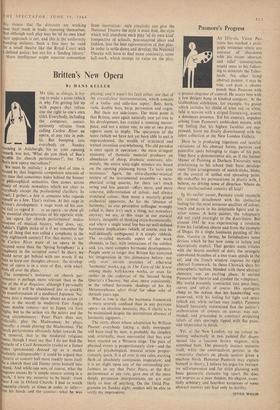Pasmore's Progress
Here he is producing ingenious and tasteful variations of his abstract forms, patterns and pointillist spots belonging to stages of his past. They have a demonstrative air, as if the former Master of Painting at Durham University were proclaiming to his school their basic develop- ment from arrangements of match-sticks, blobs, or the control of spilled and spreading paint. He reshuffles his permutations in plastic with, I believe, no driving sense of direction. Where do these intellectualised conceits all leap?
In his earlier career, Pasmore could reconcile his rational detachment with his instinctive feeling for the most sensuous qualities of colour, touch and paste in his ..delectable figure and in- terior scenes. A born painter, the voluptuary did not yield overnight to the doctrinaire. But around 1947 he was experiencing a revulsion from his fastidious charm and from the example of Degas. In a single luminous painting of this date, Garden in Spring, he foreshadows some devices which he. has now come to isolate and decoratively exploit. That garden scene vitiates with. the Seurat confetti of dots; the strangely convoluted branches of a tree trace spirals in the air; and the french window imposes its rigid abstract framework. In those Chiswick days his atmospheric realism; blended with these abstract elements, was an exciting phase. It excited Pasmore the theorist and crushed the voluptuary. His world presently contracted into pure, lines, curves and spirals of course. His apologists clung to the notion that his handwriting was preserved, NN ith hi, feeling for light and space (which any white surface may imply). Pasmore .himself buoyantly maintained that the painter's orcheStration of colours on canvas was out- moded, and, proceeded to construct projecting reliefs of slats sparingly tipped with Ilat paint, 'and impersonal in finish.
. Yet, at the New London, we see colour re- turning seductively in two painted flat shapes spread like a luscious brown unguent, with scumbled hues. The painterly instinct reasserts itself, while the constructivist persists in the concertina shutters on plastic screens given a Machine finish. However Pasmore may explain -himself in theory, I believe his urges for instinct, ive self-expression and for strict planning with basic geometric elements tug apart. He does not impress as a pure thinker; his elegant, essen- tially arbitrary and heartless, variations of some abstract motives can lead only to sterility.
NEVILE WALLIS






























 Previous page
Previous page